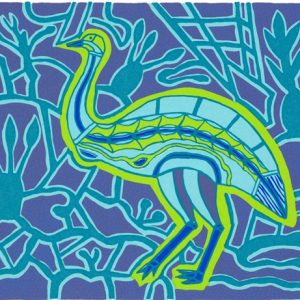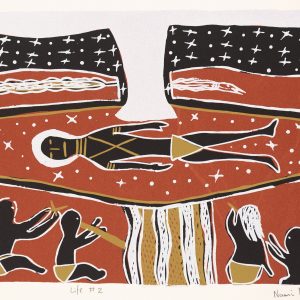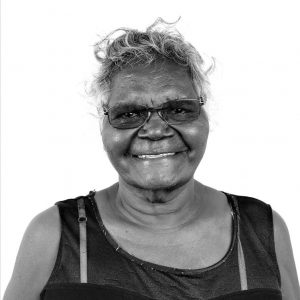Description
Artist: Nampinapu Maymuru-White
- Language Group: Mangalili/Yolngu Matha
- Region: NE Arnhem Land, NT
- Born: 1952
Story
NB: This print was created as one of a pair – the story begins with the first print: Milngiyawuy (Milky Way)
This image shows the child many years later with his own descendant family. The time has come when we are in mourning. The men are singing and the women and children are crying for the deceased. The canoe shape is the ceremonial ground, a special ground design created for ceremony. Its traditional name is Yingapungapu. Women are cutting their scalps to demonstrate their sorrow with a bingal, a pointed instrument made from kangaroo bone. Their blood is running into the ground, back to their beloved country Wayawu. Blood is sacred, no matter whether it is the afterbirth, menstrual blood or simply blood from self-inflicted wounds. In some Aboriginal groups the word for sacred is used whenever discussing women going through the menstrual cycle or after childbirth. The family gathers around and participates in the mourning ritual. The ceremony must be performed in the proper way to allow the spirit to travel in peace to its final resting place. The children watch to learn the rituals, so that they can carry them on when it is their time to do so. The cry of the guwark bird is heard as it circles around the dead. It entwines the soul of the deceased with the sacred string Burrkua Yalilyili Waymamba. The spirit cries out, ‘With this string I am going back to the sky Milngiyawuy (Milky Way) to join my ancestors; my cry will reach my destination and the echoes heard on the seas of Milngja.’
Artist Biography
Naminapu’s major interest is her art. She is an extremely versatile artist with skills in the areas of painting, carving, screen-printing, weaving, lino-cuts and batik work. As a child she used to sit for hours patiently watching her father paint. At about the age of 12, she began to learn herself, and was fortunate in being taught by her father’s brother, Narritjin Maymuru, as well as by her own father, Nånyin Maymuru. Both men were extremely able and well-known artists, whose works hang in many Australian and overseas museums. As one of the first Yolŋu women to be taught to paint miny’tji (sacred creation clan designs) she was part of the historic adaptations by the elders of the Yolŋu in the last forty years which included the revelation of previously restricted designs in pursuit of justice in the Land Rights struggle (for example The Bark Petition and The Yirrkala Church Panels).
Naminapu Maymuru was born a member of the Mangalili clan, at the Yirrkala mission station in Northeast Arnhem Land in Northern Australia in 1952. After attending the mission school, she worked for some time in the store and craft shop and also helped out in the local bank. When the Homeland Centre of Gurka’wuy was established in 1973, Naminapu went to live there with her husband and young family of three children. These were the early days of the Homeland Movement, which included the establishment by Narritjin of the Mangalili homeland of Djarrakpi (extensively documented by Ian Dunlop of Film Australia in the twenty two films of the Yirrkala Film Project). During the years she spent there, Naminapu worked as a teacher trainee and later, on her return to Yirrkala, completed her teacher training. When she later married Leon White, a teacher in the Northern Territory, Naminapu went to live for several years in Melbourne and Darwin.
She has travelled within Australia quite extensively as well as to Japan. In 1985, Naminapu returned with her husband and family to live in Yirrkala, now no longer a mission station but a locally governed Aboriginal community. Following her return, she taught art to the children at the local school and then began working at the Craft Shop attached to the Buku-Larrnggay Arts Centre. In 1990, she was appointed Curator of the recently established Art Museum attached to this Centre, a position that she held until 1996.
Naminapu’s works were exhibited very successfully with those of Banduk Marika, another Yirrkala woman artist, at a ‘dual’ exhibition held in Warnambool and Sydney, in 1990. Her works are also frequently included in combined exhibitions in Australia and overseas and she is now herself represented in most major institutional collections in the country. In August 1996 at the 13th Telstra National Aboriginal and Islander Art Awards her limited edition linoprint triptych “Nyapilingu” was chosen as the ‘Best Work on Paper’. In 1998 she was selected as the National Indigenous Heritage Art Award Joint Runner-up Normandy Art Award (for her bark “Maŋgalili”) One of her memorial poles with the Milŋiyawuy or milky way design won the Wandjuk Marika Memorial 3D award at the 2005 Telstra National Aboriginal and Torres Strait Islander Art Awards.
First Nations Fertility prints
This is one of a range of 14 limited edition screen-prints on paper exclusively available through Songlines. The prints have not been exhibited or offered for sale since 1999, the year they were created by eight Indigenous Australian women artists. Images of the prints were used as slides by Fay Nelson, then Director Aboriginal Arts Board, Australia Council, in her keynote address at the landmark Sydney IVF Fertility Conference held at Darling Harbour Conference Centre.
The prints and Dr Nelson’s essay ‘Aboriginal Fertility’ are documented in the conference proceedings published as Towards Reproductive Certainty – Fertility and Genetics beyond 1999 edited by Robert Jansen and David Mortimer with the assistance of Karen Coote, published by The Parthenon Publishing Group.
Provenance: Karen Coote








